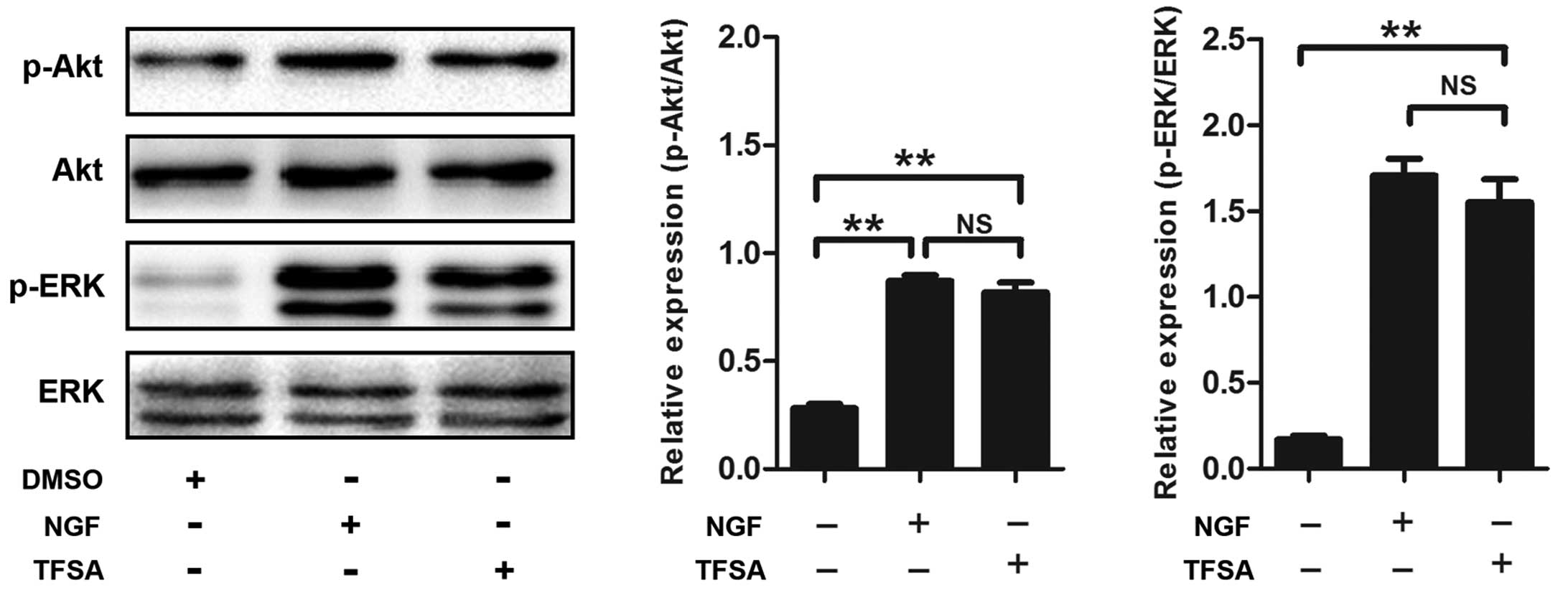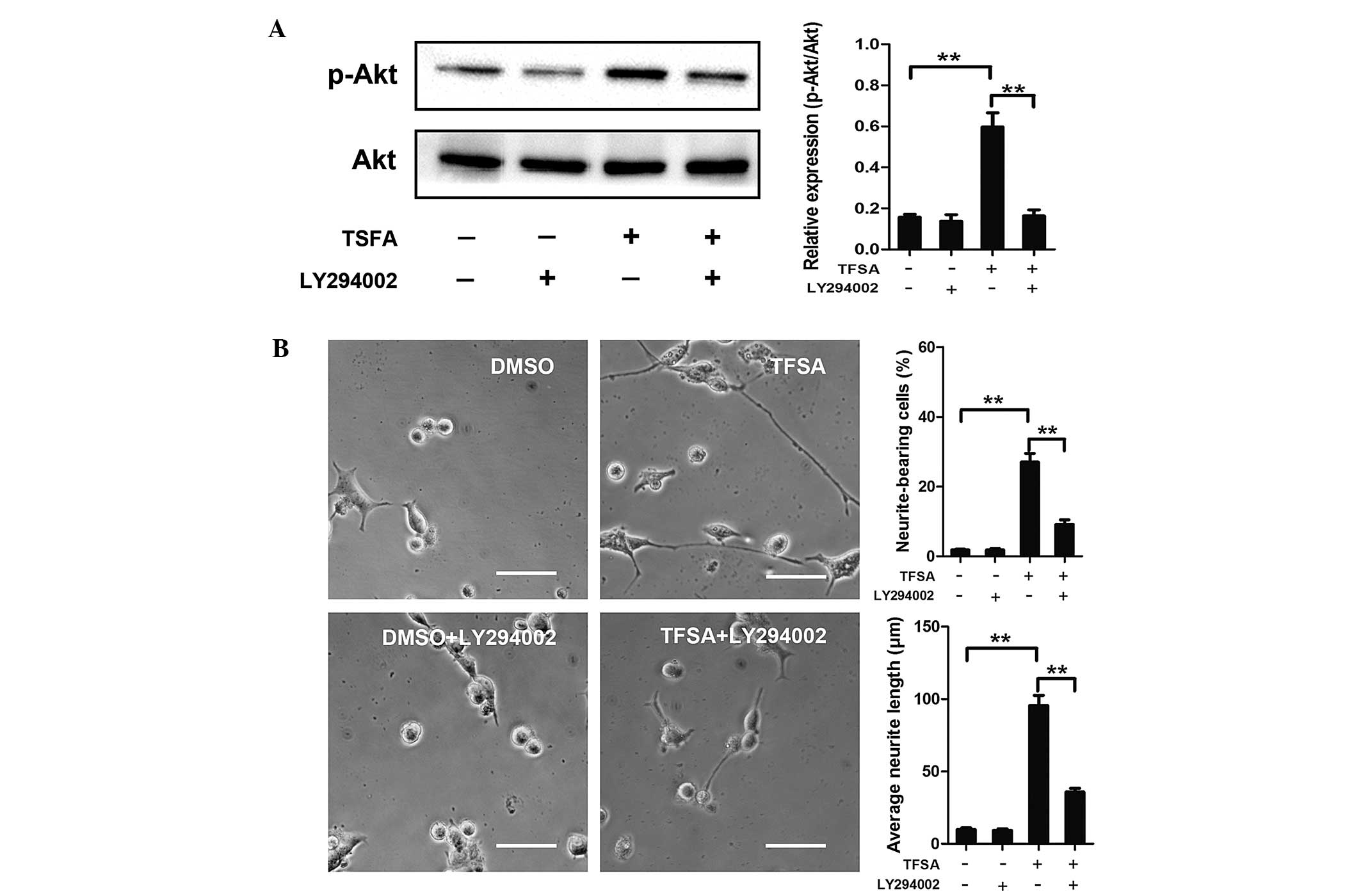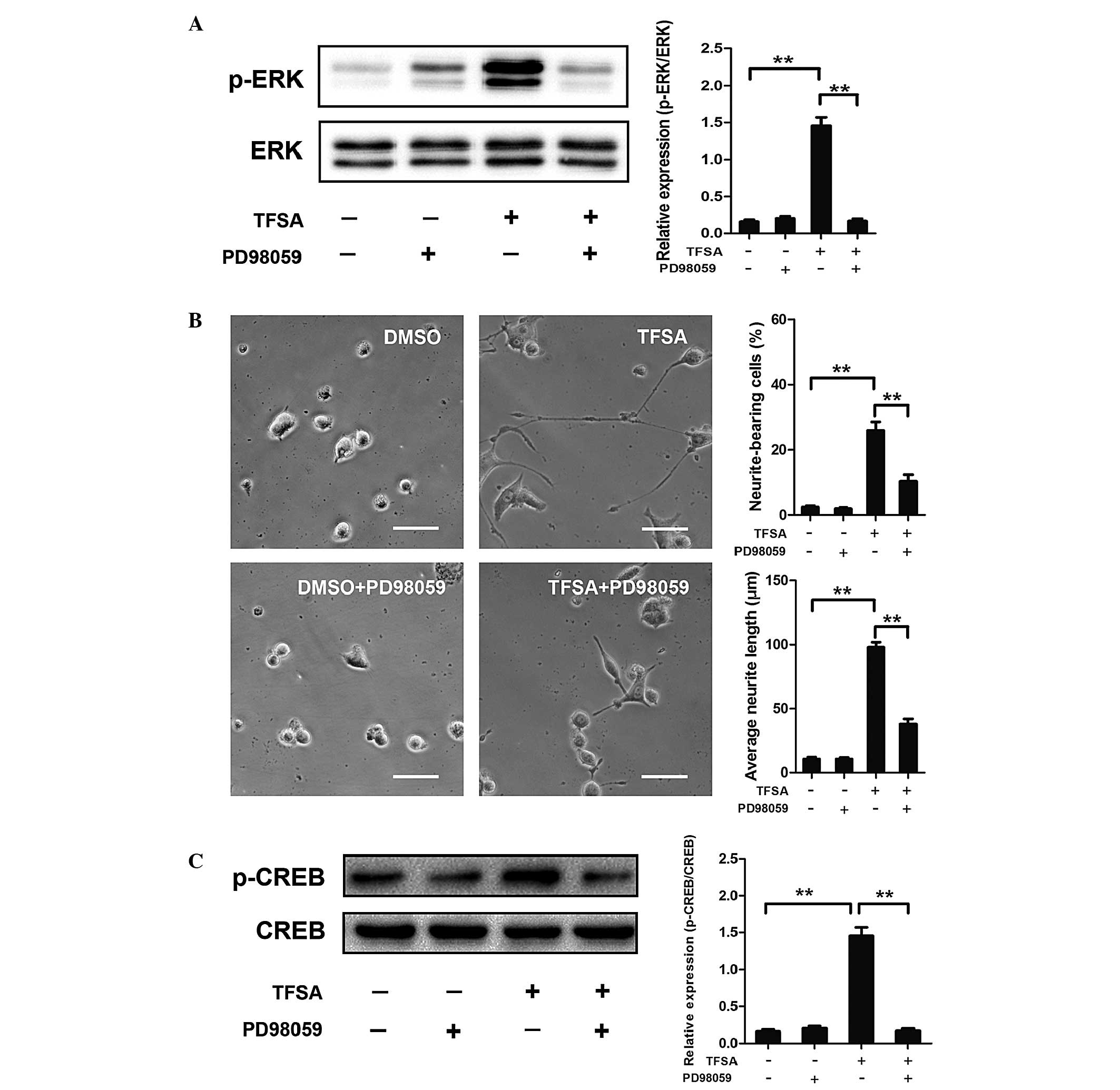Tenuifoliside A promotes neurite outgrowth in PC12 cells via the PI3K/AKT and MEK/ERK/CREB signaling pathways
- Authors:
- Published online on: September 30, 2015 https://doi.org/10.3892/mmr.2015.4397
- Pages: 7637-7642
Abstract
Introduction
The roots of Polygala tenuifolia Willd are used widely as a traditional medicine in China and Korea for the treatment of neurasthenia, amnesia and depression (1–3). Previous studies have reported that oligosaccharide esters, including tenuifolisid A (TFSA) and 3,6-disinapoyl sucrose are the predominant active components of Polygala (4), and Liu et al demonstrated that it exerted a neuroprotective effect on corticosterone-induced neuron damage in SH-SY5Y cells (3). However, the effect of TFSA on the promotion of neurite outgrowth remains to be elucidated.
PC12 cells, which are widely used as a model for investigating neurite extension, are from a cell line derived from the rat pheochromocytoma of the adrenal medulla (5). Upon treatment with nerve growth factor (NGF), PC12 cell neurite extension occurs, differentiating into morphologically and functionally neuron-like cells that express neuronal specific genes, including 43 kD growth-associated protein (GAP-43), Tuj1 and synapsin I. This process is associated with the activation of the tropomyosin-related kinase (TrkA)-dependent mitogen-activated protein kinase (MAPK) and phosphatidylinositol 3-kinase (PI3K)/Akt signaling pathways (6–8). The present study aimed to investigate the effect of TFSA on neurite outgrowth in PC12 cells, and to determine the potential involvement of the MAPK kinase (MEK)/extracellular-signal regulated kinase (ERK)/cyclic AMP response element-binding protein (CREB) and PI3K/Akt signaling pathways. Thus, the neuritogenic effects of TFSA may suggest that TFSA could be used as a potential treatment for CNS injury, including spinal cord injury.
Materials and methods
Cell culture
Rat PC12 cells were purchased from the Type Culture Collection of the Chinese Academy of Sciences (Shanghai, China) and maintained in Roswell Park Memorial Institute 1640 medium (Invitrogen Life Technologies, Carlsbad, CA, USA) supplemented with 10% heat-inactivated horse serum (Invitrogen Life Technologies), 5% fetal bovine serum (FBS; Invitrogen Life Technologies and 100 U/ml penicillin/streptomycin (Invitrogen Life Technologies) under 5% CO2 at 37°C. The medium was replaced every 3 days. For the differentiation experiments, the PC12 cells were grown in Dulbecco's modified Eagle's medium (DMEM)/F-12 media (Invitrogen Life Technologies) in the presence of 1% FBS and 100 ng/ml NGF (Sigma-Aldrich, St. Louis, MO, USA).
Measurement of neurite outgrowth
The PC12 cells (8×103) were plated in ploy-l-lysine coated 24-well plates. Neurite outgrowth was examined 48 h following treatment with NGF (100 ng/ml) or TFSA (10 µM). In certain experiments, the cells were cultured with PD98059 (10 µM; Sigma-Aldrich) or LY294002 (10 µM; Sigma-Aldrich). In each well, images were captured of 10 randomly-selected fields, each containing ~100 cells using an inverted phase contrast microscope (Nikon, Tokyo, Japan). The cells, which exhibited extension of at least one neurite with a length that was longer than the diameter of the cell body were identified as neurite-bearing cells. The neurite lengths of all neurite-bearing cells were measured using ImageJ software version 1.44p (National Institutes of Health, Bethesda, MD, USA).
Western blot analysis
The cells were lysed in radioimmunoprecipitation assay buffer (Beyotime Institute of Biotechnology, Haimen, China) containing protease inhibitor cocktails and phosphatase inhibitor cocktails (Sigma-Aldrich). The protein contents were measured using a Bicinchoninic Acid Protein Assay kit (Thermo Fisher Scientific, Waltham, MA, USA). The extracted protein samples (20 µg) were separated by 10% SDS-PAGE (KeyGen Biotech, Co., Ltd., Nanjing, China) and transferred onto polyvinylidene difluoride membranes (Merck Millipore, Darmstadt, Germany). Following blocking in 5% bovine serum albumin (Sigma-Aldrich) in phosphate-buffered saline for 2 h at room temperature, the membranes were incubated with primary antibody at 4°C overnight, and were subsequently incubated with horse anti-mouse (cat. no. 7076) or goat anti-rabbit (cat. no. 7074) IgG horseradish peroxidase-conjugated secondary antibodies (1:2,000, Cell Signaling Technology, Inc., Danvers, MA, USA) for 2 h at room temperature. The primary antibodies were as follows: Rabbit anti-rat total-ERK1/2 (monoclonal, 1:1,000; cat. no. 4695; Cell Signaling Technology, Inc., Danvers, MA, USA), rabbit anti-rat total-Akt (monoclonal, 1:1,000; cat. no. 4685; Cell Signaling Technology, Inc.), rabbit anti-rat total-CREB (monoclonal, 1:1,000; cat. no. ab32515; Abcam, Cambridge, UK), rabbit anti-rat phosphorlyated (p-) ERK1/2 (monoclonal, 1:1,000; cat. no. 4377; Cell Signaling Technology, Inc.), mouse anti-rat p-Akt (monoclonal, 1:1,000; cat. no. 4058; Cell Signaling Technology, Inc.), rabbit anti-rat p-CREB (monoclonal, 1:1,000; cat. no. ab32096; Abcam), mouse anti-rat β-actin (monoclonal, 1:2,000; cat. no. 4970; Cell Signaling Technology, Inc.) and rabbit anti-rat GAP43 (monoclonal, 1:1,000; cat. no. ab75810; Abcam). Finally, the bands were measured using an enhanced chemiluminescent system (ECL Plus; Thermo Fisher Scientific).
Statistical analysis
All numerical data are presented as the mean ± standard deviation. Statistical differences were determined using one-way analysis of variance, combined with Scheffe's test for multiple comparisons. Data were analyzed using SPSS software version 11 (SPSS, Inc., Chicago, IL, USA). P<0.05 was considered to indicate a statistically significant difference. Each experiment was replicated at least three times.
Results
TFSA induces neurite outgrowth in PC12 cells
To investigate the effect of TFSA on neurite outgrowth in PC12 cells, the cells, which were maintained in low-serum medium, were treated with either vehicle (0.1% DMSO), NGF (100 ng/ml) or TFSA (10 µM). As shown in Fig. 1A, TFSA treatment led to the promotion of neurite extension of the PC12 cells 24 h post-treatment. The percentage of neurite-bearing cells reached 25.4+5.01% following treatment with 10 µM TFSA, which was significantly higher than percentage observed in the cells treated with the vehicle.
GAP-43, a marker of neurite outgrowth, is expressed in PC12 cells on differentiation towards a neuronal phenotype and exhibits increased synthesis and axonal transport during axonal regeneration (9). The present study investigated whether TFSA affected the expression of GAP43 in the PC12 cells. At 24 h post-treatment, the results of the western blot analysis demonstrated that TFSA induced a higher expression level of GAP-43, compared with that observed in the control group (Fig. 1B).
Activation of PI3K/Akt signalling with TFSA
Subsequently, the present study investigated the signaling pathway responsible for TFSA-induced neurite outgrowth. Previous studies have demonstrated the role of the activated PI3K/Akt pathway in inducing neural differentiation in PC12 cells. In the present study, the TFSA-treated cells demonstrated a high level of phosphorlyation (p-Akt-S473), compared with the control cells (Fig. 2). To confirm the role of the PI3K/Akt signaling pathway in the neurite outgrowth induced by TFSA in the present study, LY294002., a specific pharmacological inhibitor of PI3K, was used. As shown in Fig. 3, LY294002 significantly inhibited TFSA-induced Akt phosphorylation and neurite outgrowth.
TFSA activates the MEK/ERK pathway
Previous studies have reported that signaling through MAPK classes is important in the neural differentiation of PC12 cells induced by NGF. The present study investigated whether the MEK/ERK pathway was involved in TFSA-induced neurite outgrowth in the PC12 cells. The results of the western blot analysis indicated that the phosphorylation of ERK1/2 was significantly increased in the PC12 cells, which were treated with TFSA (Fig. 2). In addition, the cells treated with PD98059, which is an MAPK/ERK kinase inhibitor, significantly inhibited TFSA-induced neurite formation (Fig. 4A and B).
TFSA promotes the phosphorylation of CREB by activating MEK/ERK
Activation of the MEK/ERK pathway in PC12 cells leads to the phosphorylation of CREB, which is critical in neurogenesis (10,11). Therefore, the present study investigated the effect of TFSA on the phosphorylation of CREB. As shown in Fig. 4C, western blot analysis revealed that the phosphorylation level of CREB was significantly increased in the TFSA treated-group of cells. To further investigate the dependence of CREB phosphorylation on the activation of the MEK/ERK pathway, the effects of PD98059 on TFSA-induced phosphorylation of CREB was detected. The results indicated that the phosphorylation of CREB was almost completely inhibited following treatment with PD98059, suggesting that the TFSA-induced phosphorylation of CREB was MEK/ERK dependent (Fig. 4C).
Discussion
TFSA is an oligosaccharide ester in Polygala. As a widely used traditional Chinese medicine, Polygala can be used to treat diseases, including amnesia, neurasthenia, palpitation and insomnia (3,4). In the present study, the effect of TFSA on neuritogenesis in PC12 cells was investigated. The results revealed that treatment with TFSA induced neuronal differentiation and increased the expression of the neuronal marker, GAP43, in PC12 cells. Furthermore, the results demonstrated that the neurite formation induced by TFSA was associated with the activation of the PI3K/AKT and MEK/ERK/CREB signaling pathways.
PC12 cells are a cell line derived from the rat pheochromocytoma of the adrenal medulla. These cells have been extensively used as a neural cell model of neurite outgrowth (12–14). Undifferentiated PC12 cells do not produce neurites (<1%), as reported in a previous study (15). The results of the present study demonstrated that TFSA induced neurite outgrowth in the PC12 cells. In addition, no significant difference was observed between TFSA and NGF in the promotion of neurite outgrowth. To further investigate the neurite outgrowth-inducing effect of TFSA, the present study examined the expression of GAP43 in the PC12 cells. Western blot analysis revealed that treatment of the PC12 cells with TFSA was associated with significant increases in the expression levels of GAP-43. GAP-43 is a major protein kinase C substrate of growing axons, which has been demonstrated to be important in growth cone formation and neurite outgrowth (16,17).
The present study also investigated the potential signaling pathway responsible for TFSA-induced neurite outgrowth in the PC12 cells. Previous studies have demonstrated that NGF activates different extracellular and intracellular signaling pathways leading to neurite outgrowth, including the PI3K/Akt and MEK/ERK pathways (18–21). In the present study, treatment with TFSA led to a significant increase in the phosphorylation of Akt at Ser473. In addition, the LY294002 PI3K inhibitor suppressed TFSA-induced neurite outgrowth, indicating the involvement of the PI3K/Akt pathway in the neuritogenic effect of TFSA. It is also known that the binding of NGF to its receptor tyrosine kinase, TrkA, activates the ERK1/2 pathway, and activation of the ERK1/2 pathway has been demonstrated to be to critical in the differentiation of PC12 cells, as the PD98059 ERK inhibitor inhibits NGF-induced neuronal differentiation (22,23). To further investigate whether the TFSA-induced neurite outgrowth involved the activation of ERK1/2 MAPK, the present study assessed the phosphorylation state of ERK1/2 in the PC12 cells. The results of the western blot analysis revealed that the degree of ERK1/2 phosphorylation increased significantly, compared with that observed in the control group, and was comparable to that detected following treatment with NGF. In addition, the outgrowth of neurites induced by TFSA was significantly inhibited by application of the PD98059 MEK inhibitor (10 µM).
As previously demonstrated, activation of the MEK/ERK pathway, induced by NGF, leads to the phosphorylation of CREB, which in turn stimulates the ability of CREB to activate transcription in NGF-treated cells (24–26). In the present study, TFSA was observed to have a similar effect. Incubation of PC23 cells with TFSA resulted in an increase in the phosphorylation of CREB, which was comparable to that induced by NGF. To elucidate whether the phosphorylation of CREB resulted from MEK/ERK activation, the PD98059 MEK inhibitor was used, which almost completely inhibited the phosphorylation of CREB induced by TFSA. These results suggested that the activation of CREB may occur via the MER/ERK pathway.
In conclusion, the present study demonstrated that TFSA promoted neurite outgrowth in the PC12 cells via the activation of pathways involved in NGF-induced neuritogenesis. Treatment with TFSA activated the MEK/ERK and PI3K/Akt pathways and triggered the phosphorylation of CREB, followed by MEK/ERK activation, in the PC12 cells.
References
|
Jiang Y, Zhang W, Tu P and Xu X: Xanthone glycosides from Polygala tenuifolia and their conformational analyses. J Nat Prod. 68:875–879. 2005. View Article : Google Scholar : PubMed/NCBI | |
|
Li C, Yang J, Yu S, Chen N, Xue W, Hu J and Zhang D: Triterpenoid saponins with neuroprotective effects from the roots of Polygala tenuifoli a. Planta Med. 74:133–141. 2008. View Article : Google Scholar : PubMed/NCBI | |
|
Liu P, Hu Y, Guo DH, Wang DX, Tu HH, Ma L, Xie TT and Kong LY: Potential antidepressant properties of Radix polygalae (Yuan Zhi). Phytomedicine. 17:794–799. 2010. View Article : Google Scholar : PubMed/NCBI | |
|
Hu Y, Liao HB, Dai-Hong G, Liu P, Wang YY and Rahman K: Antidepressant-like effects of 3,6′-disinapoyl sucrose on hippocampal neuronal plasticity and neurotrophic signal pathway in chronically mild stressed rats. Neurochem Int. 56:461–465. 2010. View Article : Google Scholar | |
|
Greene LA and Tischler AS: Establishment of a noradrenergic clonal line of rat adrenal pheochromocytoma cells which respond to nerve growth factor. Proc Natl Acad Sci USA. 73:2424–2428. 1976. View Article : Google Scholar : PubMed/NCBI | |
|
Kao S, Jaiswal RK, Kolch W and Landreth GE: Identification of the mechanisms regulating the differential activation of the mapk cascade by epidermal growth factor and nerve growth factor in PC12 cells. J Biol Chem. 276:18169–18177. 2001. View Article : Google Scholar : PubMed/NCBI | |
|
Markus A, Zhong J and Snider WD: Raf and akt mediate distinct aspects of sensory axon growth. Neuron. 35:65–76. 2002. View Article : Google Scholar : PubMed/NCBI | |
|
Vaudry D, Stork PJ, Lazarovici P and Eiden LE: Signaling pathways for PC12 cell differentiation: Making the right connections. Science. 296:1648–1649. 2002. View Article : Google Scholar : PubMed/NCBI | |
|
Frey D, Laux T, Xu L, Schneider C and Caroni P: Shared and unique roles of CAP23 and GAP43 in actin regulation, neurite outgrowth, and anatomical plasticity. J Cell Biol. 149:1443–1454. 2000. View Article : Google Scholar : PubMed/NCBI | |
|
Nakagawa S, Kim JE, Lee R, Malberg JE, Chen J, Steffen C, Zhang YJ, Nestler EJ and Duman RS: Regulation of neurogenesis in adult mouse hippocampus by cAMP and the cAMP response element-binding protein. J Neurosci. 22:3673–3682. 2002.PubMed/NCBI | |
|
Xing J, Kornhauser JM, Xia Z, Thiele EA and Greenberg ME: Nerve growth factor activates extracellular signal-regulated kinase and p38 mitogen-activated protein kinase pathways to stimulate CREB serine 133 phosphorylation. Mol Cell Biol. 18:1946–1955. 1998. View Article : Google Scholar : PubMed/NCBI | |
|
Greene LA: Nerve growth factor prevents the death and stimulates the neuronal differentiation of clonal PC12 pheochromocytoma cells in serum-free medium. J Cell Biol. 78:747–755. 1978. View Article : Google Scholar : PubMed/NCBI | |
|
Zhao CF, Liu Y, Ni YL, Yang JW, Hui HD, Sun ZB and Liu SJ: SCIRR39 promotes neurite extension via RhoA in NGF-induced PC12 cells. Dev Neurosci. 35:373–383. 2013. View Article : Google Scholar : PubMed/NCBI | |
|
Wang H, Duan X, Ren Y, Liu Y, Huang M, Liu P, Wang R, Gao G, Zhou L, Feng Z and Zheng W: FoxO3a negatively regulates nerve growth factor-induced neuronal differentiation through inhibiting the expression of neurochondrin in PC12 cells. Mol Neurobiol. 47:24–36. 2013. View Article : Google Scholar | |
|
Chang YJ, Hsu CM, Lin CH, Lu MS and Chen L: Electrical stimulation promotes nerve growth factor-induced neurite outgrowth and signaling. Biochim Biophys Acta. 1830:4130–4136. 2013. View Article : Google Scholar : PubMed/NCBI | |
|
Aigner L and Caroni P: Depletion of 43-kD growth-associated protein in primary sensory neurons leads to diminished formation and spreading of growth cones. J Cell Biol. 123:417–429. 1993. View Article : Google Scholar : PubMed/NCBI | |
|
Lalli G and Hall A: Ral GTPases regulate neurite branching through GAP-43 and the exocyst complex. J Cell Biol. 171:857–869. 2005. View Article : Google Scholar : PubMed/NCBI | |
|
Read DE and Gorman AM: Involvement of Akt in neurite outgrowth. Cell Mol Life Sci. 66:2975–2984. 2009. View Article : Google Scholar : PubMed/NCBI | |
|
Reddy EM, Chettiar ST, Kaur N, Shepal V and Shiras A: Dlxin-1, a MAGE family protein, induces accelerated neurite outgrowth and cell survival by enhanced and early activation of MEK and Akt signalling pathways in PC12 cells. Exp Cell Res. 316:2220–2236. 2010. View Article : Google Scholar : PubMed/NCBI | |
|
Hafner A, Obermajer N and Kos J: γ-Enolase C-terminal peptide promotes cell survival and neurite outgrowth by activation of the PI3K/Akt and MAPK/ERK signalling pathways. Biochem J. 443:439–450. 2012. View Article : Google Scholar : PubMed/NCBI | |
|
Cui H, Shao C, Liu Q, Yu W, Fang J, Yu W, Ali A and Ding K: Heparanase enhances nerve-growth-factor-induced PC12 cell neuritogenesis via the p38 MAPK pathway. Biochem J. 440:273–282. 2011. View Article : Google Scholar : PubMed/NCBI | |
|
Sarina, Yagi Y, Nakano O, Hashimoto T, Kimura K, Asakawa Y, Zhong M, Narimatsu S and Gohda E: Induction of neurite outgrowth in PC12 cells by artemisinin through activation of ERK and p38 MAPK signaling pathways. Brain Res. 1490:61–71. 2013. View Article : Google Scholar | |
|
Poplawski GH, Tranziska AK, Leshchyns'ka I, Meier ID, Streichert T, Sytnyk V and Schachner M: L1CAM increases MAP2 expression via the MAPK pathway to promote neurite outgrowth. Mol Cell Neurosci. 50:169–178. 2012. View Article : Google Scholar : PubMed/NCBI | |
|
Ginty DD, Bonni A and Greenberg ME: Nerve growth factor activates a Ras-dependent protein kinase that stimulates c-fos transcription via phosphorylation of CREB. Cell. 77:713–725. 1994. View Article : Google Scholar : PubMed/NCBI | |
|
Mullenbrock S, Shah J and Cooper GM: Global expression analysis identified a preferentially nerve growth factor-induced transcriptional program regulated by sustained mitogen-activated protein kinase/extracellular signal-regulated kinase (ERK) and AP-1 protein activation during PC12 cell differentiation. J Biol Chem. 286:45131–45145. 2011. View Article : Google Scholar : PubMed/NCBI | |
|
Andreassi C, Zimmermann C, Mitter R, Fusco S, De Vita S, Saiardi A and Riccio A: An NGF-responsive element targets myo-inositol monophosphatase-1 mRNA to sympathetic neuron axons. Nat Neurosci. 13:291–301. 2010. View Article : Google Scholar : PubMed/NCBI |













